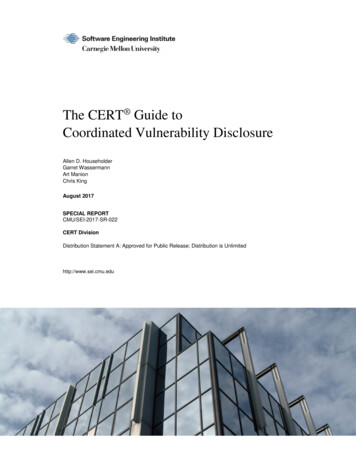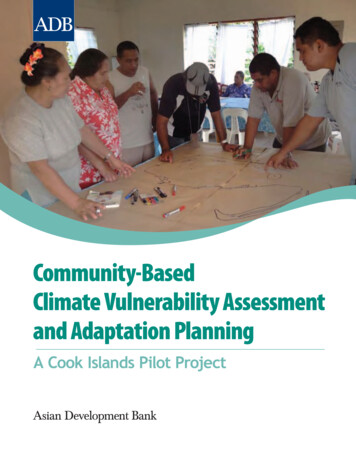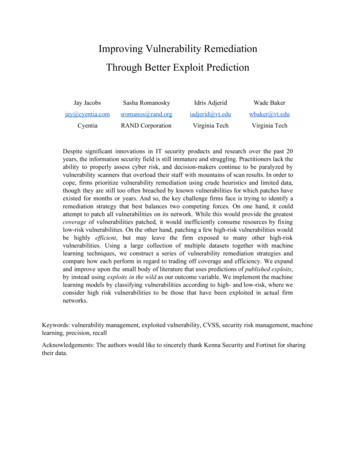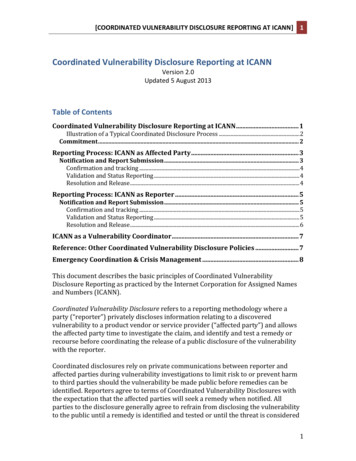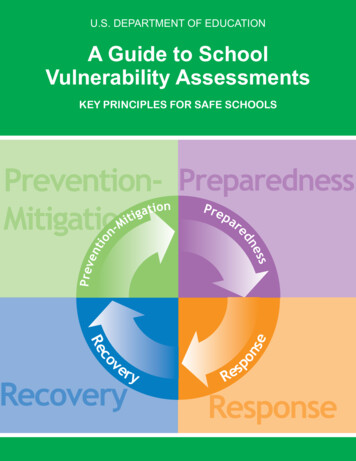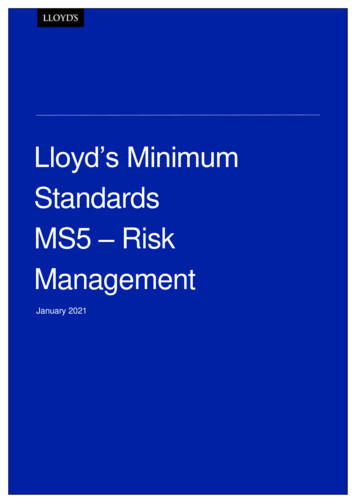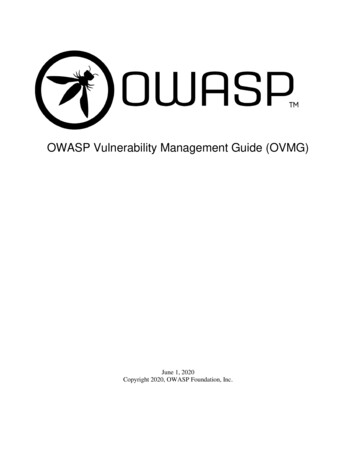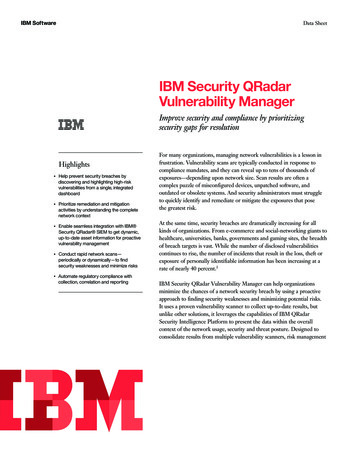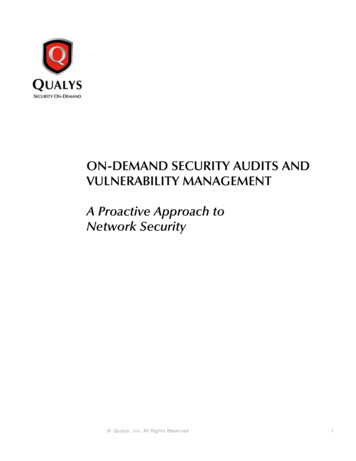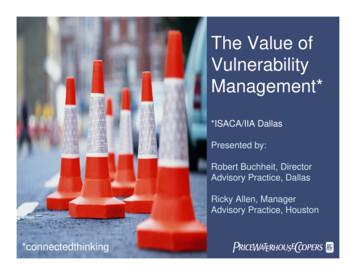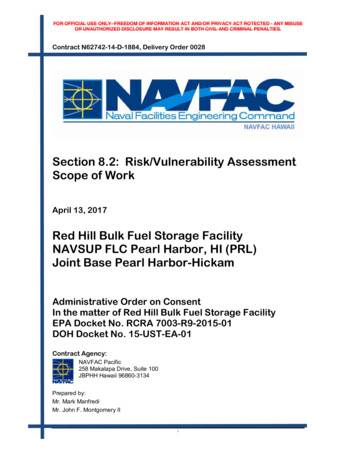
Transcription
FOR OFFICIAL USE ONLY--FREEDOM OF INFORMATION ACT AND/OR PRIVACY ACT ROTECTED - ANY MISUSEOR UNAUTHORIZED DISCLOSURE MAY RESULT IN BOTH CIVIL AND CRIMINAL PENALTIES.Contract N62742-14-D-1884, Delivery Order 0028Section 8.2: Risk/Vulnerability AssessmentScope of WorkApril 13, 2017Red Hill Bulk Fuel Storage FacilityNAVSUP FLC Pearl Harbor, HI (PRL)Joint Base Pearl Harbor-HickamAdministrative Order on ConsentIn the matter of Red Hill Bulk Fuel Storage FacilityEPA Docket No. RCRA 7003-R9-2015-01DOH Docket No. 15-UST-EA-01Contract Agency:NAVFAC Pacific258 Makalapa Drive, Suite 100JBPHH Hawaii 96860-3134Prepared by:Mr. Mark ManfrediMr. John F. Montgomery IIi
FOR OFFICIAL USE ONLY--FREEDOM OF INFORMATION ACT AND/OR PRIVACY ACT ROTECTED - ANY MISUSEOR UNAUTHORIZED DISCLOSURE MAY RESULT IN BOTH CIVIL AND CRIMINAL PENALTIES.QRVA Scope of Work Executive SummaryThe Quantitative Risk and Vulnerability Assessment (QRVA) will assess the level ofrisk the Red Hill Bulk Fuel Storage Facility (RHBFSF) may pose to the surroundinggroundwater to inform the Government in subsequent development of best availablepracticable technology (BAPT) decisions.During the scoping discussions for Section 8 of the Administaravtive Order onConsent Statement of Work (AOC SOW) all Parties agreed that a qualitative riskvulnerability assessment had limited value to support prudent decision making. AQuantitative Risk and Vulnerability Assessment was selected for providing a morerigorus and repeatable approach to evaluating risk. A normal baseline QRVA for alarge, complex facility requires 5 to 7 years to complete and is normally broken intophases. This specific baseline QRVA will be broken into four distinct phases:internal events (excluding internal fire and flooding), internal/external fire andflooding, seismic events, and other external events.The first phase of the baseline QRVA, and this scope of work, is designed to focuson internal events (not including fire or flood). This includes, but is not limited toequipment or structural failures in both frontline and support systems, human errors,etc. The report from the first phase will be submitted 18 months from the approval ofthis scope of work, in compliance with the RHBFSF AOC SOW Section 8.3. Theremaining three phases will be performed sequentially and overlapped wheretechnically feasible to better support scheduling for the AOC.As other sections of the AOC are completed and new information becomes available,future revised assessments could be done in comparison to the baseline. Sections 5and 6 of this scope of work explain this in further detail.i
FOR OFFICIAL USE ONLY--FREEDOM OF INFORMATION ACT AND/OR PRIVACY ACT ROTECTED -ANY MISUSEOR UNAUTHORIZED DISCLOSURE MAY RESULT IN BOTH CIVIL AND CRIMINAL PENALTIES.Table of ContentsPage1. Introduction1.1 Background.112. Risk Levels, Scope of Hazards, and Boundary Assessments2.1 Risk Levels.2.2 Scope of Hazards.2.3 Boundaries Assessment.2.4 Procedural Approach.2.4.1 Contractor Gathers Input Data/Parameters.2.4.2 Input Data/Parameter Review.2.4.3 Technical Work.112345773. Quantitative Risk Vulnerability Assessment3.1 Definitions of Key Terms.3.2 Description of QRVA Methodology.3.3 Assumptions and Level of Uncertainty.3.4 Evaluating and Prioritizing Events.3.5 Content and Format of Deliverables.3.6 Coordination with Other AOC-SOW Sections.3.7 Quality Control/Assurance Process.3.7.1 ISO 9001Quality Assurance.3.7.2 ASME/ANS Standard RA-S-2008 (with currentaddenda) Capability Categories.8891011111112124. Project Milestones, In-Progress Reviews, and Schedule125. Interpretation of Results and Consideration of QRVA inDecision Making246. Future Case Studies Consideration257. References2712List of TablesTable 4-1. Preliminary WBS13List of FiguresFigure 2-1. QRVA Process OverviewFigure 2-2. Project Communication Channelsii44
FOR OFFICIAL USE ONLY--FREEDOM OF INFORMATION ACT AND/OR PRIVACY ACT ROTECTED -ANY MISUSEOR UNAUTHORIZED DISCLOSURE MAY RESULT IN BOTH CIVIL AND CRIMINAL PENALTIES.List of AppendicesA.B.C.D.E.F.QRVA Proposed MethodologyQRVA Project ManagementQRVA Software ConsiderationsBibliographyGlossaryList of Acronymsiii
FOR OFFICIAL USE ONLY--FREEDOM OF INFORMATION ACT AND/OR PRIVACY ACT ROTECTED -ANY MISUSEOR UNAUTHORIZED DISCLOSURE MAY RESULT IN BOTH CIVIL AND CRIMINAL PENALTIES.1 – IntroductionThe purpose of this scope of work is to define the processes and methodologynecessary to complete phase one of the baseline Quantitative Risk and VulnerabilityAssessment (QRVA) for the Red Hill Bulk Fuel Storage Facility (RHBFSF) in compliancewith the RHBFSF Administrative Order on Consent – Statement of Work (AOC-SOW)Section 8.2. The phase one QRVA baseline report will be due 18 months from theapproval date of this scope of work. It will be designed to serve as a tool to helpfacilitate decision making that will mitigate risk and improve safety.1.1 – BackgroundThe RHBFSF site is located approximately 2.5 miles northeast of Pearl Harbor on theisland of Oahu in Hawaii. The facility lies along the western edge of the Koolau Rangeand is situated on a topographic ridge that divides the Halawa Valley and the MoanaluaValley. The site is bordered to the south by the Salt Lake volcanic crater and occupiesapproximately 144 acres of land. The surface topography varies from approximately200ft to 500ft above mean sea level.The facility consists of twenty 12.5-million-gallon, field constructed, underground storagetanks (UST) constructed in the early 1940s. The tanks are 250ft tall and 100ft indiameter, with a domed top and base. The facility currently stores Jet Propulsion FuelNo. 5 (JP-5), Jet Propulsion Fuel No. 8 (JP-8), and marine diesel (F-76). Historic fuelstorage has included diesel oil, Navy Special Fuel Oil, Navy distillate (ND), F-76, aviationgas, motor gas, JP-5, and JP-8.In January 2014, up to 27,000 gallons of JP-8 was released from Tank 5, which wasbeing returned to service after having undergone inspections, repair, and maintenance.As a result of the fuel release from Tank 5, the U.S. Environmental Protection Agency(EPA) and the Hawaii Department of Health (DOH) brought an enforcement actionagainst the Navy and the Defense Logistics Agency (DLA) to address the fuel releaseand minimize the likelihood and impact of future releases. Regulatory experience hasshown that a negotiated agreement, such as an administrative order on consent, is theappropriate enforcement tool to address such a unique facility and solve complexenvironmental problems since it allows for flexible, collaborative, and innovativesolutions. The AOC-SOW is a proactive approach that goes beyond the normal scopeof merely complying with current regulations.2 – Risk Levels, Scope of Hazards, and Boundary AssessmentsPrior to initiating technical work on a facility QRVA, it is necessary to clearly establish thedesired risk level, scope phase, and boundary assessments.2.1 – Risk Assessment Levels“Levels” of risk assessment are frequently defined to focus the evaluations such that theassociated results can efficiently and effectively support risk management. These levelsof risk assessment can be defined, as desired, by the risk analyst, but the objective of1
FOR OFFICIAL USE ONLY--FREEDOM OF INFORMATION ACT AND/OR PRIVACY ACT ROTECTED -ANY MISUSEOR UNAUTHORIZED DISCLOSURE MAY RESULT IN BOTH CIVIL AND CRIMINAL PENALTIES.defining these levels is to support an understanding of risk, which ultimately can facilitatethe development and implementation of effective risk management actions or options.The “level” of a QRVA is often best described by characterizing the key figure(s) of meritdesired to be developed and quantified via the QRVA. For example, any or all of thefollowing levels of QRVA could be pursued for a RHBFSF QRVA: Level 1 – Frequency (and Annual Probability) of Loss of Fuel InventoryControl (by Volume Range) within the RHBFSF Property Boundaries Level 2 – Frequency (and Annual Probability) of Uncontrolled Release of FuelInventory (by Volume Range) Outside the RHBFSF Property Boundaries thatCould Impact Red Hill Groundwater Shaft Water Quality Level 3 – Frequency (and Annual Probability) of Exceeding Public WaterSupply Quality Levels or Limits (e.g., within the Red Hill groundwater shaft)Directly Associated with Uncontrolled Release of Fuel Inventory outside theRHBFSF Property Boundaries Level 4 – Frequency (and Annual Probability) of Public Deaths (or Injuries orIllnesses) Directly Associated with Uncontrolled Release of Fuel Inventoryoutside the RHBFSF Property BoundariesExperience has shown that Levels 1 and/or 2 above are often adequate to facilitateeffective risk management decision-making for the facility owner/operator. The QRVAdescribed in this SOW focuses on a Level 2 risk assessment, as defined above. Theresult of this risk assessment can provide evaluation information and metrics to supportwork being executed under the AOC-SOW Sections 6 and 7 which can supportexpansion of the risk assessment to a Level 3 assessment for the Red Hill groundwatershaft, as desired and directed by the Navy. Other QRVA levels can, of course, bedefined through modification or supplementation of the risk metrics outlined above.2.2 – Scope of HazardsNext, the scope of hazards to be addressed within the QRVA must be specified.Industry experience, supplemented by industry standards for risk assessment, hasestablished that a comprehensive QRVA should generally consider risks from the hazardsources below. They are grouped into phases, which are recommended to efficientlycharacterize the scope of hazards to be addressed in the RHBFSF QRVA: Phase 1 – Internal Events (not including fire or flood) Equipment or structural failures in both frontline and support systems,human errors, etc. Phase 2 – Internal and External Fire and Flood Events Internal flooding Internal fires Internal sabotage (not included within the scope of this analysis forsecurity reasons) External flooding, tsunami, and heavy precipitation External fires2
FOR OFFICIAL USE ONLY--FREEDOM OF INFORMATION ACT AND/OR PRIVACY ACT ROTECTED -ANY MISUSEOR UNAUTHORIZED DISCLOSURE MAY RESULT IN BOTH CIVIL AND CRIMINAL PENALTIES. Phase 3 – Seismic Events Earthquakes Phase 4 – Additional External Events High Winds Storms (tornados, hurricanes, etc.) Landslides (or mud slides) Proximity Transportation Accidents Aircraft Crashes External Hazardous Material or Chemical Spills or Releases Extreme Weather (e.g., high temperature, etc.) Terrorist Acts (not included within the scope of this analysis for securityreasons) Other Facility-Specific Hazards (often location-dependent hazards thatcan be special cases of other general hazard sources)As part of this scope of work, Phase 1 scope of hazards will be assessed in the QRVASOW and delivered to the regulating agencies 18 months from the approval of thisscope of work, in accordance with the AOC. The remaining phases will be assessed inthe normal linear progression of a QRVA outside of this scope of work (see Section 4).2.3 – Boundaries of AssessmentThe scope of a QRVA is defined via clear and comprehensive characterization ofassessment boundaries. First, the functional and physical boundaries of the facility to beassessed must be clearly defined. The functional boundaries are facility-specific,depending upon the processes performed by or at the facility. The physical boundariesare generally defined by specifying the target property lines, structures, systems, andcomponents (SSC) considered to be within the facility functional boundaries. Functionaland physical boundaries are generally those supported by existing as-built, as-operateddesign basis documentation (DBD). DBD includes currently-effective documentationand schematic drawing information associated with the as-built, as-operated facility.DBD includes all effective documentation associated with facility design, operation,maintenance, and testing; e.g., documentation associated with the initial information itemrequest presented in Section 2.4.1 of this SOW.Closely related to analysis boundaries is the issue of the physical and functional basis orstarting point for the QRVA. An effective design freeze date must be established toensure a stable design basis for the QRVA. Regarding determination of the RHBFSFdesign basis for the QRVA, the following design basis has been selected by the Navy:Freeze the facility design as of the date of approval of this scope of work. Thedesign basis will be the as-built, as-operated facility as of the scope of work approvaldate, to include design, operation, maintenance, and testing changes that have beenapproved and funded as of that date, but with no additional modification options.3
FOR OFFICIAL USE ONLY--FREEDOM OF INFORMATION ACT AND/OR PRIVACY ACT ROTECTED -ANY MISUSEOR UNAUTHORIZED DISCLOSURE MAY RESULT IN BOTH CIVIL AND CRIMINAL PENALTIES.2.4 – Procedural ApproachThe overall process flow for the RHBFSF baseline QRVA is summarized in Figure 2-1.SMEsEPA/DOHContractor GathersInput Data/Parameters;i.e., Site-SpecificEmpirical, etc.Input Data/ParameterReviewStatusUpdatesIndependentPeer Review(option)QRVAQRVA ReportNavy/DLAFigure 2-1. QRVA Process OverviewThe lines of communication for the QRVA process is summarized in Figure 2-2.Figure 2-2. QRVA Lines of Communication4
FOR OFFICIAL USE ONLY--FREEDOM OF INFORMATION ACT AND/OR PRIVACY ACT ROTECTED -ANY MISUSEOR UNAUTHORIZED DISCLOSURE MAY RESULT IN BOTH CIVIL AND CRIMINAL PENALTIES.2.4.1 – Contractor Gathers Input Data/ParametersAn initial data request will include, but not be limited to:1. RHBFSF general site and facility layout and arrangement drawings.2. A comprehensive set of RHBFSF P&IDs or equivalent flow and/or logic diagrams.3. Tank and piping isometric drawings or similar layout diagrams.4. System description documentation.5. A comprehensive electronic list of all SSCs included within the scope of the QRVA,including alpha-numeric component ID numbers, system designators, specificcomponent service descriptions, component types, component locations, andreference(s) to SSC design documentation. This list should include all tanks, piping,pumps, valves, electric power, and associated instrumentation and controlsequipment required to operate the facility.6. SSC design documentation, preferably in electronic format, including design orbuilding code information; e.g., American Petroleum Institute (API) and/or AmericanSociety of Mechanical Engineers (ASME) code information for tanks.7. Structure and component seismic design criteria.8. RHBFSF site location scheme; e.g., areas, zones, rooms, or compartments withassociated location (e.g., 3D coordinate system) information. If fire zones have beendesignated for this facility based on fire area and barrier criteria, this information ispreferred.9. All facility operating and maintenance procedures, including normal and emergency(incident response) operating procedures and policies.10. Facility operating logs, preferably for the entire history of the facility, but for at leastthe last 5 years (e.g., 2012 to present) of facility operation.11. A list of all historical incidents involving hydrocarbon or other fuel or material releasefrom facility tanks and systems, to include not only tank or piping rupture events, butalso releases associated with human errors; e.g., during fuel or other fluid tank fill,tank emptying, or other transfer, maintenance, or testing operations. This includesall Unplanned Fuel Movement (UFM) reports and associated corrective action taken.12. Loss of fuel inventory incident reports over the entire history of the facility.13. Either the record of all fuel movements over the past 5 years or an expected realisticfacility operating profile to be used in the QRVA; i.e., average demand loading for allRHBFSF equipment over the long term. This includes estimates for run time anddemand cycle numbers for all RHBFSF equipment per year over the long term(e.g., pump on/off cycles and run time, valve open/closure cycles, tank fill/offload5
FOR OFFICIAL USE ONLY--FREEDOM OF INFORMATION ACT AND/OR PRIVACY ACT ROTECTED -ANY MISUSEOR UNAUTHORIZED DISCLOSURE MAY RESULT IN BOTH CIVIL AND CRIMINAL PENALTIES.cycles and timing, piping segment active flow time and standby/rest time, equipmentsensor cycles and monitoring time, instrumentation and control equipment actuationcycles and monitoring time, and power source energize/de-energize cycles andpower provision time over the long term).14. The full text of any previous facility risk and vulnerability assessments and other riskassessment reports performed for the RHBFSF, along with all associatedappendices, models, and databases.15. Other documentation deemed pertinent to RHBFSF QRVA, as determined by DOD.Information collection, review, and data management will be performed in accordancewith standard quality assurance/quality control practices defined in Section 3.7 of thisdocument.Data applied in the QRVA are generally documented and applied within relationaldatabases embedded within the QRVA software applied for event sequencequantification, RISKMAN , in this project. Typical quantitative parameters required fora QRVA include: Initiating Event Frequency Values Scenario-Related Failure Exposure Parameters-Calendar Time ExposureMission Time or Operating Time ExposureMission Demand Exposure -Basic Event Probability Values Developed Using the Exposure Parametersabove with:Component Failure Rates (time-based and demand-based)Human Failure Event Human Error Probability Values Common Cause Failure Parameter Values Based on Common Cause FailureGroup Size (e.g., α, β, γ, and δ values) System or Component Alignment FractionsThe general process for developing and managing these data is as follows: Identify the data parameters necessary to support the QRVA. Obtain industry generic data for these parameters via industry data sources. Obtain data for SSCs similar to those in operation at the QRVA target facility(the RHBFSF in this case). Obtain facility-specific data, from the owner/operator of the target facility, theNavy in this case, primarily from the RHBFSF operator, the Joint Base PearlHarbor Fuels Department.6
FOR OFFICIAL USE ONLY--FREEDOM OF INFORMATION ACT AND/OR PRIVACY ACT ROTECTED -ANY MISUSEOR UNAUTHORIZED DISCLOSURE MAY RESULT IN BOTH CIVIL AND CRIMINAL PENALTIES. Combine these data mathematically to formulate appropriate parameterentries for QRVA event sequence quantification, primarily via application ofBayesian update techniques (see Appendix A for details).Generic data applied in the QRVA will be taken from reputable documented references.Most current references for generic data, such as NUREG/CR-6928, apply Gammafunctions to characterize time-based initiating event frequency values and equipmentfailure rates, and they apply Beta functions for demand-based failure rates. Thatpractice will be followed for this QRVA. In general, Poisson distributions, sometimesused as examples in this SOW, will not be applied in the actual QRVA, and Beta functiondistributions will be applied instead, in accordance with current standard data analysispractices (see NUREG/CR-6928).Any documented component-specific degradation model information provided by theNavy or AOC stakeholders via the communication channel presented in Figure 2-2 willbe evaluated and considered for application in the QRVA. While the data parameterswill reside in the applied QRVA software, RISKMAN, in this project, these parameterswill be extracted into common tabular format; e.g., via Microsoft (MS) Excel or MSAccess tables, for technical review and verification. Each data parameter applied in theRHBFSF QRVA will have a pedigree documented within the QRVA report, including theinformation sources applied in the development of the parameter. In some cases,engineering judgment may be applied to estimate some QRVA input parameters. Whenengineering judgment is so applied, the QRVA report will provide documentation of thebases and assumptions supporting development of each of these input data parameters.All data applied in the QRVA will not only have a documented pedigree, but will alsohave a documented preparer, reviewer, and approver within the Contractor.2.4.2 – Input Data/Parameter ReviewUpon completion of the QRVA data analysis task, the QRVA data will be made availablefor review by the Navy, Regulators, and SMEs; e.g., the EPA, DOH, DLNR, USGS,BWS, etc. This review is scheduled to be conducted over a 2-week time period. Thedocumented review comments on this data review will be evaluated and resolved by theContractor via written response approximately 2 weeks after receipt of all reviewcomments2.4.3 – Technical WorkTechnical work on the RHBFSF QRVA will be conducted applying the methodology,guidelines, and procedures outlined in the QRVA Methodology presented in Appendix Aof this SOW. Primary guidance information sources include the following: American Nuclear Society (ANS) and Institute of Electrical and ElectronicEngineers, “PRA Procedures Guide: A Guide to the Performance ofProbabilistic Risk Assessments for Nuclear Power Plants,” sponsored by theU.S. Nuclear Regulatory Commission and the Electric Power ResearchInstitute, NUREG/CR-2300, April 1983 (Reference 3).7
FOR OFFICIAL USE ONLY--FREEDOM OF INFORMATION ACT AND/OR PRIVACY ACT ROTECTED -ANY MISUSEOR UNAUTHORIZED DISCLOSURE MAY RESULT IN BOTH CIVIL AND CRIMINAL PENALTIES. U.S. Nuclear Regulatory Commission, “PSA Procedures Guide,” NUREG/CR2815, 1985 (Reference 4). American Institute of Chemical Engineers Center for Chemical ProcessSafety, “Guidelines for Chemical Process Quantitative Risk Analysis,”2nd Edition, October 1999 (Reference 5).Additional guidance for special QRVA topics and tasks is provided via the referencescited in Section 7, Appendix A, and via the information sources included in thebibliography of this SOW.3 – Quantitative Risk and Vulnerability Assessment3.1 – Definitions of Key TermsThe definitions of some key terms applied in QRVA are presented in this section. Acomprehensive list of QRVA terms and definitions is presented in Appendix E. Somedefinitions of fundamental QRVA terms are presented as follows:Risk: The combined answer to three questions that consider (1) what can gowrong?, (2) how likely is it?, and (3) what are the potential consequences? Moresophisticated definitions of risk include a fourth question: (4) what is our level ofuncertainty (or confidence) associated with the answers to the first three questions?Hazard: Anything that has the potential to initiate or cause an undesired sequenceof events and/or conditions to occur that leads to an undesired consequence.Examples of QRVA hazards are facility equipment failures, human errors, fires,floods, earthquakes, adverse weather, etc.Vulnerability: Weakness in the design or operation of a system, component, orstructure that could increase the probability of disabling its function and, thus,contribute, in a potentially significant way, to overall facility risk.Initiating Event: An event that perturbs the steady state operation of the facility andcould lead to an undesired facility condition. This is an event that can start orprecipitate a sequence of additional events or conditions that ultimately result in anundesired consequence.Basic Event: An element of the QRVA model for which no further decomposition isperformed because it is at the limit of resolution consistent with available data.Probability: The likelihood that an event will occur as expressed by the ratio of thenumber of actual occurrences to the total number of possible occurrences.Frequency: The actual (historical) or expected (future) number of occurrences of anevent or accident condition expressed per unit of time.Boolean Logic: A branch of algebra in which all operations are either true or false;i.e., yes or no, and all relationships between the operations can be expressed with8
FOR OFFICIAL USE ONLY--FREEDOM OF INFORMATION ACT AND/OR PRIVACY ACT ROTECTED -ANY MISUSEOR UNAUTHORIZED DISCLOSURE MAY RESULT IN BOTH CIVIL AND CRIMINAL PENALTIES.logical operators such as AND, OR, or NOT. Invented by English mathematicianGeorge Boole.3.2 – Description of QRVA MethodologyThe details of the QRVA methodology to be applied on this project are presented inAppendix A of this SOW. A conceptual overview of general QRVA activities is presentedas follows: Facility Familiarization and QRVA Scope DeterminationInitiating Event AnalysisEvent Sequence (Event Tree) AnalysisSystem (Failure Modes and Effects Analysis [FMEA] and Fault Tree) AnalysisData Analysis (including Dependent Events Analysis)Human Reliability AnalysisEvent Sequence Quantification (including Uncertainty Analysis)Risk Results Compilation (e.g., Detailed Risk Matrix)Risk Decomposition and Vulnerability AssessmentQRVA Documentation and Communication (Presentation)The Contractor must first review and evaluate facility information, such as that identifiedin the initial information request items presented in Section 2.4, to become thoroughlyfamiliar with facility SSCs and the operational profile of the facility. This includes reviewof facility operating, maintenance, and testing procedures for both normal andemergency operating conditions.The team then conducts an analysis of potential event sequence initiating events,specifically initiating event frequencies, which may be precipitated via the hazardsconsidered within the scope of the QRVA. For this QRVA, these hazards are thoseidentified in Section 2.2 of this SOW.The team then develops qualitative event sequences that could lead to undesiredconsequences contributing to risk. For this QRVA, the primary undesired consequenceis the uncontrolled release of fuel from the RHBFSF.The event sequence analysis is conducted via event tree analysis. The team conductsfacility system FMEA and fault tree analysis to characterize event tree top events andsplit fractions. To support quantification of QRVA event sequences, data analysis mustbe performed to support quantification of event tree split fractions. Quantification ofevent tree split fractions is supported primarily via fault tree quantification. The dataanalysis is performed to quantify initiating event frequencies and conditional probabilityof individual event tree split fractions for event sequence quantification. The event treesplit fraction conditional probability values are derived primarily via fault treequantification. The data analysis includes derivation of fault tree basic event probabilityvalues. In developing event sequences and fault trees for a facility QRVA, it isnecessary to identify human actions (e.g., facility operator actions) that may contribute tofacility event sequences. Human reliability analysis (HRA) is performed to identify andcharacterize these actions in terms of human failure events (HFE) for the fault trees and9
FOR OFFICIAL USE ONLY--FREEDOM OF INFORMATION ACT AND/OR PRIVACY ACT ROTECTED -ANY MISUSEOR UNAUTHORIZED DISCLOSURE MAY RESULT IN BOTH CIVIL AND CRIMINAL PENALTIES.event trees. HRA also includes evaluation of HFE human error probability (HEP) valuesfor application within the event sequence quantification.When the fault tree models are completed and quantified, and the split fraction data isentered into the event trees, the event sequences can then be quantified, and baselinerisk can be determined. Fault tree analysis and quantification and event tree analysisand quantification are accomplished via state-of-the-art QRVA software packages, suchas RISKMAN, to be applied on this project. The data for fault tree and event treequantification are entered as probability distributions in the QRVA software. Uncertaintyanalysis is performed by propagating the input data probability distributions through thefault tree and event tree quantifications processes applying either a Monte Carlo or aLatin-Hypercube process in RISKMAN, resulting in a probability distribution for thebaseline risk. Baseline risk results are compiled and expressed via a table of resultssometimes called a risk matrix.After the baseline risk results have been determined, the vulnerability assessment isperformed by decomposing the risk into its component parts in a number of ways. Weapply what are known as risk importance measures to decompose the total baseline riskinto fractional risk contributors by event sequence, initiating event group, etc. We alsocalculate risk importance measures down to the basic component failure mode andhuman failure event levels of risk contributors to develop ranked lists of these risk modelelements. These ranked lists of contributors by initiating event group, event sequence,and individual basic events or fundamental elements of risk contribution provide valuableinsight into the vulnerability of the facility to risk. Finally, the baseline risk results and thevulnerability assessment are documented in a report in terms that can support prudentdecision-making for the facility.3.3 – Assumptions and Level of UncertaintyThe bases and assumptions associated with the QRVA will be clearly documented in theQRVA report. In QRVA, every effort is made to develop and apply realistic “bestestimate” models and data. In some cases, simplifying assumptions may be applied
effective risk management decision-making for the facility owner/operator. The QRVA described in this SOW focuses on a Level 2 risk assessment, as defined above. The result of this risk assessment can provide evaluation information and metrics to support work being executed under the AOC-SOW Sections 6 and 7 which can support
